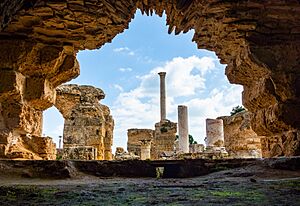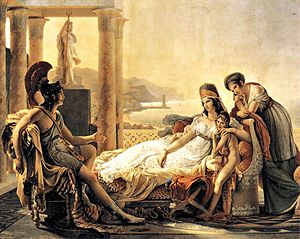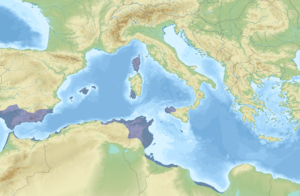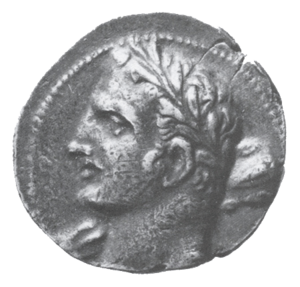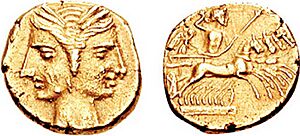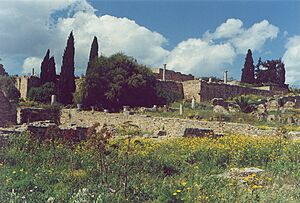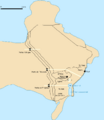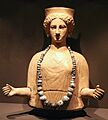History of Carthage facts for kids
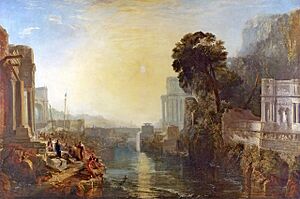
The ancient city of Carthage was founded a very long time ago, around 800 BC, in Northwest Africa. This area is now the country of Tunisia. Carthage started as a small settlement built by people called the Phoenicians. They came from a city called Tyre (in what is now Lebanon) and wanted to create trading posts across the Mediterranean.
Carthage grew from a small trading post into a powerful empire. It became one of the most important trading centers in the western Mediterranean. But this success led to a big conflict with the rising Roman Republic. These long and fierce wars were called the Punic Wars (264–146 BC). In the end, Rome completely destroyed Carthage in 146 BC.
Later, the Romans built a new city on the same spot, which became known as Roman Carthage. This Roman city also thrived for many centuries. However, it was eventually destroyed again by Arab invaders in the late 7th century. After that, a new city called Tunis became the main center in the region. Today, the ancient ruins of Carthage are part of a modern suburb of Tunis.
Contents
How Carthage Began
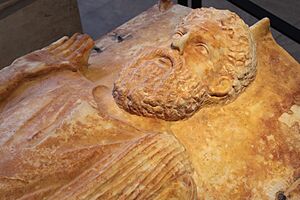
Carthage was one of many settlements created by the Phoenicians. The Phoenicians were skilled traders and sailors from the eastern Mediterranean, in what is now Lebanon. They built many cities along the coasts to help with their trade.
In the 10th century BC, the Phoenicians were very successful. The Greeks gave them the name "Phoenicians." These people relied a lot on trade, both by land and by sea. Their cities had many important ports. To help their merchant ships, they set up colonies all over the Mediterranean, from Spain to the Black Sea.
The Phoenicians needed these colonies for a few reasons. They wanted places for their ships to rest and resupply. They also wanted to control important natural resources, like metals. And sometimes, they just wanted to trade directly.
The most important Phoenician city was Tyre. Tyre set up about 300 colonies in places like Tunisia, Morocco, Algeria, and Spain. Most of these colonies were small, with fewer than 1,000 people. But Carthage, along with a few others, grew much larger and became independent. The Phoenicians also controlled islands like Cyprus, Sardinia, Malta, and parts of Sicily.
The first colonies were set up on the routes to Spain, which was rich in minerals. Tyre was the center of the Phoenician world. But after many attacks and its destruction by Alexander the Great, Tyre's power faded. Sidon and then Carthage took over as leaders. At first, colonies paid tribute to Tyre or Sidon, but they weren't directly controlled. This changed with Carthage. Carthage appointed its own leaders to rule the towns and kept much more control.
Carthage became one of the wealthiest cities in the world because of its trade. They traded things like textiles, metals, food, and even slaves. One very valuable product they made and sold was Tyrian purple dye, which came from shellfish.
Dido and the Founding Story
The name "Carthage" in the Phoenician language means "New City." Historians believe Carthage was founded around 814 BC. Another Phoenician city, Utica, was actually older than Carthage. Its name means "old," which fits this idea.
The main Phoenician city, Tyre, was the first to settle Carthage. It probably started as a stopping point for Tyre's ships on their way to trade for metals in southern Spain. These stops were often set up every 30 to 50 kilometers along the African coast. Carthage eventually grew to be more important than all other Phoenician settlements.
There's a famous legend about how Carthage was founded. It says that a queen from Tyre, named Elissa (also called Dido), founded the city in 814 BC. Dido's story is told by the Roman historian Pompeius Trogus. He says that Dido's brother, King Pygmalion, killed her husband. So, Queen Elissa (Dido) fled Tyre with some nobles and royal treasure. They sailed to Northwest Africa and founded Carthage.
According to the legend, a local tribal chief wanted to marry Dido. But Dido wanted to honor her dead husband. So, she publicly took her own life. After this, she was celebrated as a goddess in Carthage. The Roman poet Virgil also wrote about Dido in his epic poem, the Aeneid. He made her a tragic hero who met the Trojan hero Aeneas in Carthage.
Carthage was likely chosen by the people of Tyre for its great location. It was on the central coast of the Gulf of Tunis, which gave it easy access to the Mediterranean Sea. It was also protected from bad storms. The city was close to the important Strait of Sicily, a key point for trade between the east and west.
The land itself was also valuable. Carthage was built on a hilly peninsula with a lake nearby, providing fish and a safe harbor. The peninsula was connected to the mainland by a narrow strip of land, making the city easy to defend. A fortress was built on a hill called Byrsa, overlooking the sea. Carthage became a hub for two major trade routes: one for raw materials from Spain to Tyre, and another between North Africa and the northern Mediterranean (Sicily, Italy, Greece).
Becoming a Powerful Empire
Not much is known about the early history of Carthage. At first, it paid a yearly tribute to local Libyan tribes. It might have even been ruled by a governor from Tyre. For a long time, Carthage was probably just like other Phoenician colonies in Africa.
But by the end of the 7th century BC, Carthage started to develop its own unique "Punic" culture. This showed that a new culture was growing in the Western Mediterranean. Around 650 BC, Carthage started its own colony. By 600 BC, it was fighting wars against the Greeks on its own.
When the city of Tyre was attacked by the Babylonians around 585 BC, Carthage was likely already independent. However, it still kept close ties with Tyre, sometimes sending yearly tribute to the temple of Melqart (a god). Carthage didn't inherit an empire from Tyre; it had to build its own.
Carthage became a powerful trading empire. It established new colonies and helped protect older Phoenician cities from attacks. It also expanded its own lands by conquering new areas. Some Phoenician colonies willingly joined Carthage, paying tribute and letting Carthage handle their foreign policy. But others, especially in Spain and Sardinia, resisted Carthaginian control.
Unlike Rome, Carthage didn't focus on conquering lands right next to the city first. Because it depended so much on trade, it built an overseas empire before expanding much inland in Africa. This might have been because powerful Libyan tribes prevented expansion nearby for a while. Carthage even paid rent to the Libyans for land around the city until about 450 BC.
Carthage's control over its territories varied. Lands closest to the city were controlled very strictly. Carthaginian officers managed these areas, and Punic troops were stationed in the cities. Many cities had to destroy their defensive walls. Libyans living there had few rights and had to pay a yearly tribute (a large part of their farm produce and town income). They also had to serve in the Carthaginian army.
Other Phoenician cities paid a yearly tribute and managed their own affairs. They kept their defensive walls but couldn't have their own foreign policy. Allies like Utica and Gades were more independent. In return for giving up some control, these cities got protection from Carthage. Carthage's powerful fleet fought piracy and protected them from outside threats.
Carthaginian citizenship was very exclusive. The state focused more on protecting its trade network than on expanding its number of citizens. This was different from Rome, which often expanded its citizen body by adding allies. Carthage had treaties with many cities, outlining their rights and areas of influence.
Kings and Conflicts
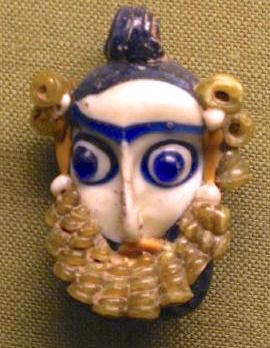
Carthage was first ruled by kings. These kings were chosen by the Carthaginian senate for a certain time. They were war leaders, managed the city, and performed religious duties. Over time, their power became less absolute. Military command went to professional officers, and two officials called "suffets" took over some of the king's civic duties. Eventually, kings were no longer elected.
The Phoenicians didn't face much resistance when they developed their trade. Even when the Etruscans became a sea power, it didn't hurt Phoenician trade much. Carthage and Etruscan cities even had treaties to manage their trade.
Carthage's success and its reliance on shipping led to a very strong Carthaginian navy. This navy helped stop pirates and rival nations. As Carthage grew more powerful, it started to clash more and more with the Greeks. The Greeks were another major power trying to control the central Mediterranean. The Etruscans, who were also fighting the Greeks, became allies of Carthage in these struggles.
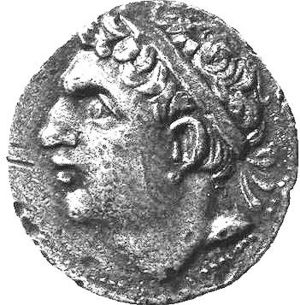
By the mid-6th century BC, Carthage was a fully independent "thalassocracy," meaning a state that rules the seas. Under a general named Mago and his family, Carthage became the most important among the Phoenician colonies in the western Mediterranean. Mago started the practice of hiring soldiers from other peoples and mercenaries, because Carthage's own population was too small to defend such a large empire. So, Libyans, Iberians, Sardinians, and Corsicans joined the Carthaginian army.
Carthaginian traders sailed all over the western Mediterranean. They set up trading posts that often grew into cities. These included places like Palermo in Sicily, Ibiza in the Balearic Islands, and Cartagena in Spain. Carthage also had an alliance with the Etruscans in Italy.
Carthaginian ships even sailed into the Atlantic Ocean. A sailor named Himilco explored north of the Strait of Gibraltar, possibly reaching modern France. Another sailor, Hanno the Navigator, explored south along the African coast, far past the River Gambia. Carthaginian traders were very secretive about their trade routes, especially about keeping the Strait of Gibraltar closed to the Greeks.
Conflicts with the Greeks
The conflicts between Carthage and the Greeks were mostly about money and trade, not about different ideas or cultures. Both sides wanted to expand their influence. Carthage's economy relied on keeping rivals away. Greek colonists posed a threat because they offered better products, tried to take over trade networks, and attacked Carthaginian ships.
Greek colonization in the Western Mediterranean began around 750 BC. Hundreds of Greek colonies appeared along the Italian and Sicilian coasts. At first, Phoenicians moved to the western part of Sicily to avoid clashes. But this changed around 638 BC, when Greek traders visited Spain. By 600 BC, Carthage was actively fighting the Greeks to stop their expansion. Carthaginian interests in Spain, Sardinia, and Sicily were threatened.
In 480 BC, Hamilcar, a Carthaginian general, led a large army to Sicily to fight Syracuse, a powerful Greek city. But the Greeks won a major victory at the Battle of Himera. This led to a long period of fighting between Syracuse and Carthage.
Later, in 311 BC, Carthaginian armies under another Hamilcar defeated a Greek leader named Agathocles near Syracuse. Agathocles then tried a daring plan: he sailed his army to Africa, very close to Carthage itself. This made the city very worried. But Carthage eventually defeated Agathocles. After this, the Greek world, busy with conquering the Persian Empire, lost interest in expanding its colonies in Sicily. Rome, a new power, began to replace Greek influence in the western Mediterranean.
During these centuries, Carthage expanded its trade. It grew its markets along the African coast, in southern Spain, and on the islands of the western Mediterranean. It also started trading across the Sahara Desert and explored new trade opportunities in the Atlantic. Carthage also took direct control over the Numidian Berber people in the lands around the city, which became more prosperous.
The Philaeni Brothers
There's a legend about how Carthage and the Greek city of Cyrene decided on their border in Libya. Two pairs of champions started running from Carthage and Cyrene on the same day, running towards each other. When they met, the Carthaginian runners had covered more ground. The Greeks accused them of cheating. So, the Carthaginian pair agreed to be buried alive on the spot where they met. This way, the land between that spot and Carthage would become part of Carthage. These Carthaginian champions were brothers, called Philaeni. The border was marked by two pillars called the "Altars of the Philaeni."
The Sicilian Wars
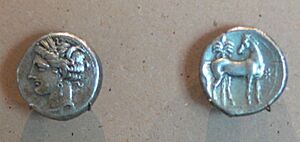
After the defeat in the First Sicilian War (480 BC), Carthage changed its government. The old nobility was replaced by a republic. A king was still elected, but the senate and a group called the "Tribunal of 104" gained more power. Carthage also focused on expanding in Africa and Sardinia, and exploring new markets in Africa and Europe.
In 410 BC, a Carthaginian general named Hannibal Mago led an army to Sicily to help a city called Segesta. He defeated the army of Selinus and then attacked and destroyed Himera. About 3,000 Greek prisoners were killed by Hannibal to get revenge for the death of his ancestor Hamilcar at Himera.
Wars Against Dionysius
Dionysius I of Syracuse ruled Syracuse for 38 years and fought four wars against Carthage. In 406 BC, Hannibal Mago led another Carthaginian army to Sicily. He captured the cities of Akragas, Gela, and Camarina, and defeated Dionysius's army many times. Eventually, Himilco, Hannibal's kinsman, made a peace treaty with Dionysius. This treaty allowed Greek settlers to return to some cities, but they had to pay tribute to Carthage.
In 398 BC, Dionysius broke the peace treaty. His soldiers killed Carthaginian traders in Syracuse, and he attacked and destroyed the Carthaginian city of Motya in Sicily. Himilco, who was now "king," responded strongly. He recaptured Motya and also took Messina. He then besieged Syracuse itself. But in 396 BC, a plague hit the Carthaginian army, and they collapsed under Syracusan attack. Himilco paid a large sum of money to Dionysius for his citizens to leave safely. He left his mercenary soldiers behind and sailed back to Carthage. After his death, the power of the "kings" in Carthage was greatly reduced.
The plague also spread to Carthage, and a big rebellion broke out in Africa. Carthage was under siege, and its navy was essential for supplying the city. The wars with Dionysius continued for many years, with both sides winning and losing battles. Eventually, a peace treaty was signed in 338 BC, which kept Carthaginian lands in Sicily mostly the same.
The Pyrrhic War
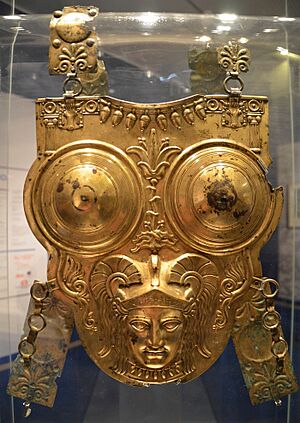
Between 280 and 275 BC, a Greek king named Pyrrhus of Epirus fought two major campaigns. One was against the rising power of Rome in Italy, and the other was against Carthage in Sicily. The Greek cities in Sicily asked Pyrrhus for help to remove Carthaginian control. Carthage had attacked Syracuse and was besieging the city.
Pyrrhus agreed to help and sailed to Sicily. He was very successful at first, pushing back the Carthaginian forces and capturing the fortress city of Erice. However, he couldn't capture Lilybaeum. Carthage asked for peace, but Pyrrhus refused unless Carthage gave up all its claims on Sicily.
Pyrrhus then wanted to conquer Carthage itself. But his harsh treatment of the Sicilian cities made them turn against him. So, Pyrrhus left Sicily and returned to Italy. His fleet was defeated by Carthage, and his campaigns in Italy also failed. For Carthage, this meant things went back to normal. But for Rome, Pyrrhus's failure meant that Rome gained control over the Greek colonies in Italy. This brought Rome closer to controlling all of Italy and set the stage for future conflicts with Carthage.
Conflict with Rome: The Punic Wars
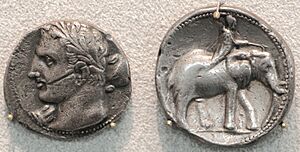
As early as 509 BC, Carthage and Rome signed treaties about trade. Later treaties were also made. But eventually, their different interests led to big disagreements and conflicts.
The island of Sicily, right next to Carthage, became the main battleground. Both Greeks and Phoenicians had set up many colonies there. Small battles had been fought for centuries. Carthage had to deal with several Greek invasions.
When a group of Italian mercenaries, called the Mamertines, took over the city of Messana in Sicily, they became a threat to both Carthage and Syracuse. In 265 BC, Hiero II, the new leader of Syracuse, attacked them. The Mamertines asked for help from both Carthage and Rome.
Carthage quickly sent soldiers to Messana. A Carthaginian fleet sailed into the harbor. But then, they started negotiating with Hiero. The Mamertines got worried and asked Rome to kick out the Carthaginians.
Carthage's military presence in Messana meant they were right across the narrow channel from Italy. This gave them control over the Strait of Messina and was a clear danger to Rome. The Roman senate debated what to do, and the people voted to intervene.
The Roman attack on Carthaginian forces at Messana started the first of the Punic Wars. Over the next century, these three major wars between Rome and Carthage would decide the future of the Western world.
First Punic War (264–241 BC)
This war started over one town in Sicily but grew into a struggle for the whole island. It became a naval war, where the Romans learned how to fight at sea. They eventually defeated the Carthaginian fleet. Carthage lost Sicily and had to pay a huge amount of money to Rome. Carthage was not ready to fight against such a strong power.
After this defeat, Carthage's mercenary soldiers revolted against them. This threatened the very survival of Carthage. But Carthage managed to survive, thanks to leaders like Hanno II the Great and Hamilcar Barca. During this crisis, Rome refused to help the rebels. However, Rome later took over Sardinia.
Second Punic War (218–201 BC)
The Second Punic War was largely caused by the anger of Hamilcar Barca (father of Hannibal) and Rome's takeover of Sardinia. But the immediate cause was a dispute over a city in Spain called Saguntum. After winning there, Hannibal Barca led his armies north, eventually crossing the Alps into Italy.
Hannibal ("grace of Baal") won huge victories against Rome in Italy, at Trasimeno (217 BC) and Cannae (216 BC). These victories almost destroyed Rome's ability to fight. But most of Rome's Italian allies stayed loyal. Rome used all its resources and rebuilt its army. For many years, Hannibal stayed in Italy, keeping his army supplied and threatening Rome.
Meanwhile, Roman forces began to fight Carthage for control of Spain. By 206 BC, the war in Spain had turned against Carthage. The Roman general Publius Cornelius Scipio (later called Africanus) decisively defeated Carthaginian power there.
In 204 BC, Roman armies under Scipio landed in Africa, near Carthage. This forced Hannibal to return to Africa to defend his homeland. At the Battle of Zama in 202 BC, Scipio Africanus, with help from the Numidian cavalry led by King Masinissa, defeated Hannibal Barca. This ended the long war.
Carthage lost all its trading cities and silver mines in Spain, and its other lands in the western Mediterranean. It also lost its influence over the Berber Kingdoms, which became independent Roman allies. Carthage was reduced to its immediate surroundings and had to pay a very large amount of money to Rome over fifty years.
However, Carthage soon recovered and became prosperous again. It no longer had to spend money on defense. But the anti-Carthage group in Rome, led by the politician Cato, wanted to destroy Carthage completely. Cato famously ended all his speeches in the Roman Senate by saying, Carthago delenda est! ("Carthage must be blotted out!").
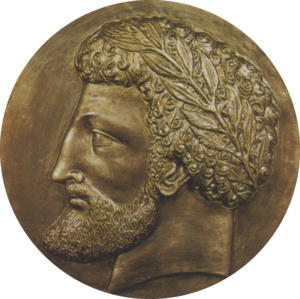
Despite this, some Romans, like Scipio Africanus, favored a more generous policy towards Carthage. There were also many cultural exchanges between Rome and Carthage. For example, a Carthaginian named Hasdrubal became a famous Greek philosopher in Athens. But despite these connections, war came again.
Third Punic War (149–146 BC)
The Third Punic War began after Carthage fought with the Numidian king Masinissa. Masinissa had been attacking and provoking Carthage for decades. When Carthage finally fought back, it broke its treaty with Rome.
Rome, determined to destroy Carthage, cleverly hid its true intentions. Carthage gave up important military resources during talks. Then, Rome gave Carthage an ultimatum: either leave the city so it could be destroyed, or face war. Carthage refused to leave. Roman armies landed in Africa and began to besiege the magnificent city.
The end came in 146 BC. Carthage was destroyed. The Romans pulled the Phoenician warships into the harbor and burned them. They went from house to house, killing and enslaving the people. The city was set on fire and completely ruined.
Roman Carthage
After Carthage fell, its nearby rival, Utica, which was a Roman ally, became the capital of the region. But the site of Carthage was so important that Julius Caesar and later Augustus decided to rebuild it as a Roman city.
The new city of Carthage was built on the same land. By the 1st century AD, it was the second-largest city in the western half of the Roman Empire. It had a population of 500,000 people. It was the center of the Roman province of Africa, which was a major "breadbasket" (food supplier) for the empire.
Carthage also became an important center for early Christianity. Many Christians lived there. In the 4th century, the Biblical canon (the list of books in the Bible) for the Western Church was confirmed at the Council of Carthage.
In 429 AD, the Vandals, a Germanic people, crossed into Africa. They fought against the Roman forces and established the Vandal Kingdom. In the 6th century, the Byzantines (the Eastern Roman Empire) finally conquered the Vandals. The Byzantine general Belisarius entered Carthage in 533 AD, saving it from destruction.
Carthage became an "Exarchate," a special province, for the Byzantine Empire. But the Byzantine Exarchate couldn't withstand the Arab conquerors in the 7th century. The Arabs finally overran the Exarchate of Africa in 698 AD. The people were moved to the nearby town of Tunis, which then became the main regional center. The materials from Carthage were used to help Tunis grow. This marked the end of the Byzantine Empire's influence in the region.
Modern Carthage
Today, modern Carthage is a suburb of Tunis, the capital city of Tunisia. For about 900 years, Carthage was just a small farming village. But since the mid-20th century, it has grown quickly into an upscale coastal suburb. In 2013, its population was estimated to be over 21,000 people.
In 1985, the mayors of Rome and Carthage signed a symbolic treaty. This "officially" ended the conflict between their cities, which had supposedly lasted for more than 2,100 years because there was no peace treaty after the Punic Wars!
Carthage is now a popular tourist attraction. The Carthage Palace, which is the Tunisian presidential palace, is located in the city. Modern Carthage has become a political center, a "place of emblematic power," even though Tunis remains the economic and administrative capital.
Images for kids
-
Adorned Statue of the Punic Goddess Tanit, 5th–3rd centuries BC, from the necropolis of Puig des Molins, Ibiza (Spain), now housed in the Archaeology Museum of Catalonia (Barcelona)
-
A Punic bronze coin from Gadir, modern Cádiz (Spain); the obverse shows a male head depicting Melkart (called Heracles by the Greeks and Hercules by the Romans); on the reverse are two tuna fish with several Phoenician letters.
-
Sicily, Entella. Punic issues. Circa 320–300 BC. AR Tetradrachm (26 mm, 16.84 g, 7h). Head of Arethousa left, wearing wreath of grain ears, triple-pendant earring, and necklace; three dolphins around / Head of horse left; palm tree to right, Punic ‘MMḤNT below.
See also
 In Spanish: Historia de Cartago para niños
In Spanish: Historia de Cartago para niños
- Carthage tophet
- Asterius Chapel


